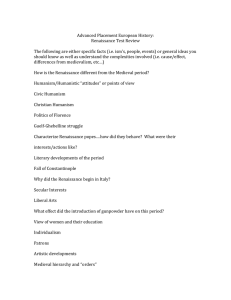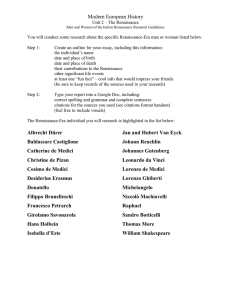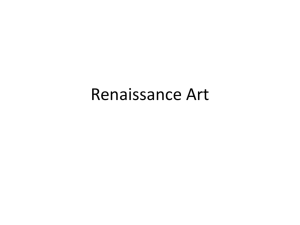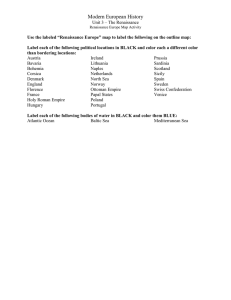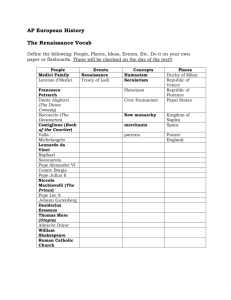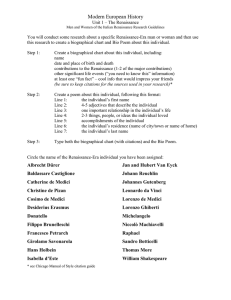People of the Renaissance (Chapter 13 pg. 413-447)
advertisement
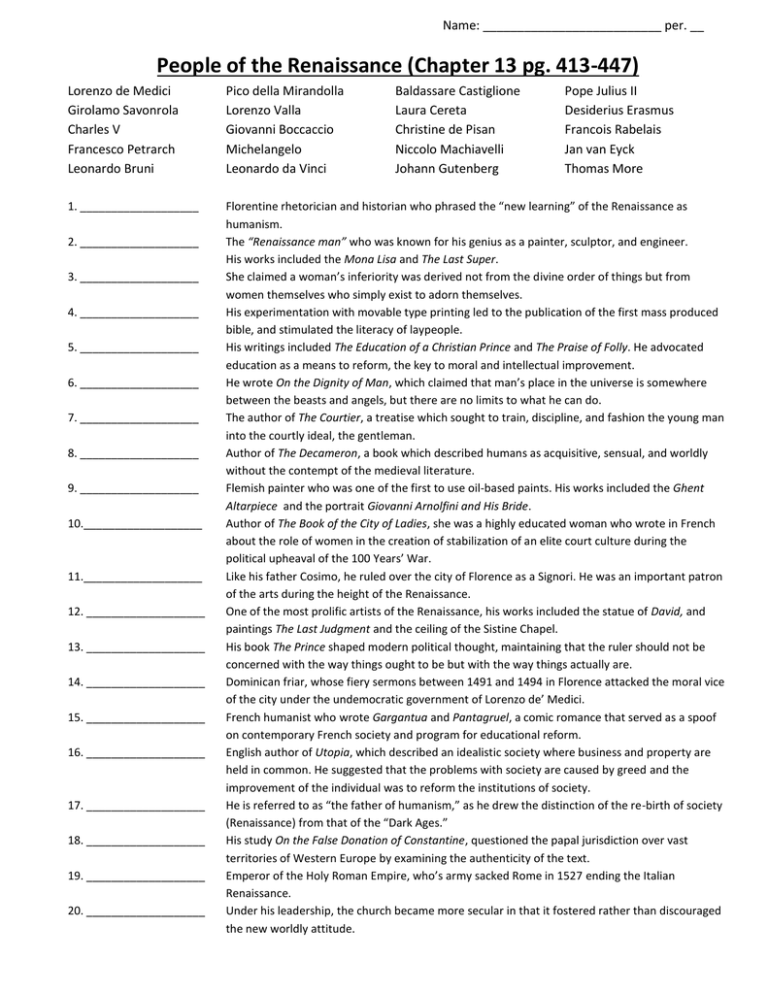
Name: __________________________ per. __ People of the Renaissance (Chapter 13 pg. 413-447) Lorenzo de Medici Girolamo Savonrola Charles V Francesco Petrarch Leonardo Bruni Pico della Mirandolla Lorenzo Valla Giovanni Boccaccio Michelangelo Leonardo da Vinci 1. ___________________ Florentine rhetorician and historian who phrased the “new learning” of the Renaissance as humanism. The “Renaissance man” who was known for his genius as a painter, sculptor, and engineer. His works included the Mona Lisa and The Last Super. She claimed a woman’s inferiority was derived not from the divine order of things but from women themselves who simply exist to adorn themselves. His experimentation with movable type printing led to the publication of the first mass produced bible, and stimulated the literacy of laypeople. His writings included The Education of a Christian Prince and The Praise of Folly. He advocated education as a means to reform, the key to moral and intellectual improvement. He wrote On the Dignity of Man, which claimed that man’s place in the universe is somewhere between the beasts and angels, but there are no limits to what he can do. The author of The Courtier, a treatise which sought to train, discipline, and fashion the young man into the courtly ideal, the gentleman. Author of The Decameron, a book which described humans as acquisitive, sensual, and worldly without the contempt of the medieval literature. Flemish painter who was one of the first to use oil-based paints. His works included the Ghent Altarpiece and the portrait Giovanni Arnolfini and His Bride. Author of The Book of the City of Ladies, she was a highly educated woman who wrote in French about the role of women in the creation of stabilization of an elite court culture during the political upheaval of the 100 Years’ War. Like his father Cosimo, he ruled over the city of Florence as a Signori. He was an important patron of the arts during the height of the Renaissance. One of the most prolific artists of the Renaissance, his works included the statue of David, and paintings The Last Judgment and the ceiling of the Sistine Chapel. His book The Prince shaped modern political thought, maintaining that the ruler should not be concerned with the way things ought to be but with the way things actually are. Dominican friar, whose fiery sermons between 1491 and 1494 in Florence attacked the moral vice of the city under the undemocratic government of Lorenzo de’ Medici. French humanist who wrote Gargantua and Pantagruel, a comic romance that served as a spoof on contemporary French society and program for educational reform. English author of Utopia, which described an idealistic society where business and property are held in common. He suggested that the problems with society are caused by greed and the improvement of the individual was to reform the institutions of society. He is referred to as “the father of humanism,” as he drew the distinction of the re-birth of society (Renaissance) from that of the “Dark Ages.” His study On the False Donation of Constantine, questioned the papal jurisdiction over vast territories of Western Europe by examining the authenticity of the text. Emperor of the Holy Roman Empire, who’s army sacked Rome in 1527 ending the Italian Renaissance. Under his leadership, the church became more secular in that it fostered rather than discouraged the new worldly attitude. 2. ___________________ 3. ___________________ 4. ___________________ 5. ___________________ 6. ___________________ 7. ___________________ 8. ___________________ 9. ___________________ 10.___________________ 11.___________________ 12. ___________________ 13. ___________________ 14. ___________________ 15. ___________________ 16. ___________________ 17. ___________________ 18. ___________________ 19. ___________________ 20. ___________________ Baldassare Castiglione Laura Cereta Christine de Pisan Niccolo Machiavelli Johann Gutenberg Pope Julius II Desiderius Erasmus Francois Rabelais Jan van Eyck Thomas More
